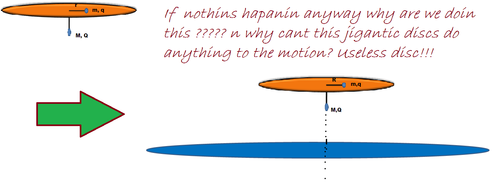Unchanged oscillations
 Initially a system of two particles of masses connected by strings m=3kg charge q and M=8kg charge Q exist where m is on the frictionless table rotating with some angular velocity. The mass M is in equilibrium. Now we pull the mass M by some distance downwards. It oscillates with a certain frequency. We do the experiment again by placing a large disc of surface charge density
so that its centre lies just below M. Surprisingly we find that the frequency of oscillations is unchanged. Find
assume that the charges are approximately at the same level (height) w.r.t the disc.
also assume that the electrostatic forces are negligible between the two small charges throughout.
Initially a system of two particles of masses connected by strings m=3kg charge q and M=8kg charge Q exist where m is on the frictionless table rotating with some angular velocity. The mass M is in equilibrium. Now we pull the mass M by some distance downwards. It oscillates with a certain frequency. We do the experiment again by placing a large disc of surface charge density
so that its centre lies just below M. Surprisingly we find that the frequency of oscillations is unchanged. Find
assume that the charges are approximately at the same level (height) w.r.t the disc.
also assume that the electrostatic forces are negligible between the two small charges throughout.
The answer is -2.
This section requires Javascript.
You are seeing this because something didn't load right. We suggest you, (a) try
refreshing the page, (b) enabling javascript if it is disabled on your browser and,
finally, (c)
loading the
non-javascript version of this page
. We're sorry about the hassle.
Let us first see why the initial set up oscillates in the first place.
when we pull the mass M down , since the angular momentum of the disc is conserved angular velocity will increase on reduction in radius of its path due to pulling down the hanging block. The increment in angular velocity and decrement in the radius are so related that the tension force will not be sufficient to provide the sufficient acceleration thus causing the disc to increase the radius of its path by simultaneously pulling the hanging M, setting up oscillations in the system in such a way that the hanging mass M starts up and down oscillations and the mass m radial oscillations.
let the initial angular velocity of the mass m be ω 0
ω 0 r 2 = ω 1 ( r − x ) 2
m ω 1 2 ( r − x ) − m ω 0 2 r ) = ( m + M ) a
we get angular frequency of oscillations as ω = ω 0 m + M 3 m
Now comes the tricky part how can we find the force due to a charged disc. let the radius of the disc be a with charge b
let us consider a cylindrical gaussian surface of small radius x and length 2z symmetrical to the centre of the cylinder.
for this small radius we can consider that the vertical component of electric field near the axis doesn't vary with x
the flux can be given by ε 0 a 2 b x 2 = 2 a 2 2 k b ( 1 − z 2 + a 2 z ) ( π x 2 ) + 2 ∫ 0 z E r a d i a l 2 π x d z
by diffrenciating and applying newtons libnitz formula we obtain
E r a d i a l = ( z 2 + a 2 ) 3 / 2 k b x here as a is very large we can neglect x
the main aim of me giving this question was to find this approximation.
for the time period or frequency to be the same it is necessary that no other external forces restore the system.
Δ E v e r t i c a l Q + Δ E r a d i a l q = 0
a 3 2 k Q b x = − a 3 k q b
Q q = − 2